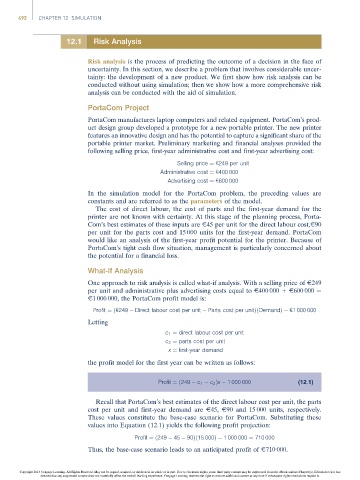Page 512 -
P. 512
492 CHAPTER 12 SIMULATION
12.1 Risk Analysis
Risk analysis is the process of predicting the outcome of a decision in the face of
uncertainty. In this section, we describe a problem that involves considerable uncer-
tainty: the development of a new product. We first show how risk analysis can be
conducted without using simulation; then we show how a more comprehensive risk
analysis can be conducted with the aid of simulation.
PortaCom Project
PortaCom manufactures laptop computers and related equipment. PortaCom’s prod-
uct design group developed a prototype for a new portable printer. The new printer
features an innovative design and has the potential to capture a significant share of the
portable printer market. Preliminary marketing and financial analyses provided the
following selling price, first-year administrative cost and first-year advertising cost:
Selling price ¼ e249 per unit
Administrative cost ¼ e400 000
Advertising cost ¼ e600 000
In the simulation model for the PortaCom problem, the preceding values are
constants and are referred to as the parameters of the model.
The cost of direct labour, the cost of parts and the first-year demand for the
printer are not known with certainty. At this stage of the planning process, Porta-
Com’s best estimates of these inputs are E45 per unit for the direct labour cost,E90
per unit for the parts cost and 15 000 units for the first-year demand. PortaCom
would like an analysis of the first-year profit potential for the printer. Because of
PortaCom’s tight cash flow situation, management is particularly concerned about
the potential for a financial loss.
What-If Analysis
One approach to risk analysis is called what-if analysis. With a selling price of E249
per unit and administrative plus advertising costs equal to E400 000 + E600 000 ¼
E1 000 000, the PortaCom profit model is:
Profit ¼ðe249 Direct labour cost per unit Parts cost per unitÞðDemandÞ e1 000 000
Letting
c 1 ¼ direct labour cost per unit
c 2 ¼ parts cost per unit
x ¼ first-year demand
the profit model for the first year can be written as follows:
Profit ¼ð249 c 1 c 2 Þx 1 000 000 (12:1)
Recall that PortaCom’s best estimates of the direct labour cost per unit, the parts
cost per unit and first-year demand are E45, E90 and 15 000 units, respectively.
These values constitute the base-case scenario for PortaCom. Substituting these
values into Equation (12.1) yields the following profit projection:
Profit ¼ð249 45 90Þð15 000Þ 1 000 000 ¼ 710 000
Thus, the base-case scenario leads to an anticipated profit of E710 000.
Copyright 2014 Cengage Learning. All Rights Reserved. May not be copied, scanned, or duplicated, in whole or in part. Due to electronic rights, some third party content may be suppressed from the eBook and/or eChapter(s). Editorial review has
deemed that any suppressed content does not materially affect the overall learning experience. Cengage Learning reserves the right to remove additional content at any time if subsequent rights restrictions require it.

